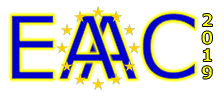Speaker
Description
Advanced accelerator concepts usually address linear acceleration schemes. Storage rings, however, are often superior to linear machines regarding repetition rate, stability and efficiency. The radiative energy loss per turn in an electron storage ring is compensated by radiofrequency resonators with a wavelength of the order of 1 meter, which corresponds to the spacing between consecutive potential wells, so-called buckets, and a bunch length around 1 centimeter or several 10 picoseconds. As an alternative, this function could be performed by a laser wave co-propagating with the electrons in an undulator. Considering a continuous-wave carbondioxide laser beam as an example, the bucket spacing would be 10 micrometer with a bunch length in the femtosecond range. The paper will discuss chances and limitations of such a laser-driven storage ring concept with steady-state femtosecond bunches. Possible preparatory experimental studies at existing storage rings will be outlined.

